- Erie's Public Schools
- Participating Schools & Lessons
- Diehl Elementary School
-
 at
at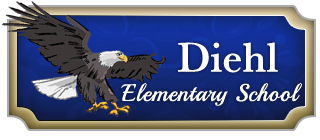 Diehl Elementary is a K – 8 neighborhood school and part of the Erie Public Schools. Located at 2327 Fairmount Parkway, Diehl is home to approximately 550 students.Diehl focuses on meeting the needs of the students while teaching specific content at each grade aligned with the PA Common Core standards. These standards require a rigorous and comprehensive curriculum and a wide range of subjects from World History, Geography, American History, Music, the Sciences, Literature, Writing, Mathematics, and the Visual Arts. With this in mind, an integrative approach to STEM education was adopted approximately 3 years ago. Teachers are encouraged to choose STEM design challenges that correlate to existing science instruction and provide ample opportunities for participating students to experience both science inquiry and the engineering design process.Diehl provides instruction to all students through inclusion classrooms. The integrated approach to STEM works well for all students providing challenge as well as collaborative learning groups and problem solving strategies for all involved.Scientific Inquiry
Diehl Elementary is a K – 8 neighborhood school and part of the Erie Public Schools. Located at 2327 Fairmount Parkway, Diehl is home to approximately 550 students.Diehl focuses on meeting the needs of the students while teaching specific content at each grade aligned with the PA Common Core standards. These standards require a rigorous and comprehensive curriculum and a wide range of subjects from World History, Geography, American History, Music, the Sciences, Literature, Writing, Mathematics, and the Visual Arts. With this in mind, an integrative approach to STEM education was adopted approximately 3 years ago. Teachers are encouraged to choose STEM design challenges that correlate to existing science instruction and provide ample opportunities for participating students to experience both science inquiry and the engineering design process.Diehl provides instruction to all students through inclusion classrooms. The integrated approach to STEM works well for all students providing challenge as well as collaborative learning groups and problem solving strategies for all involved.Scientific Inquiry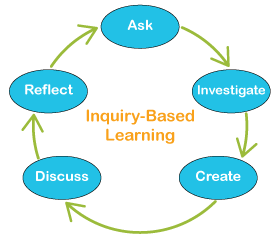 Engineering Design Process
Engineering Design Process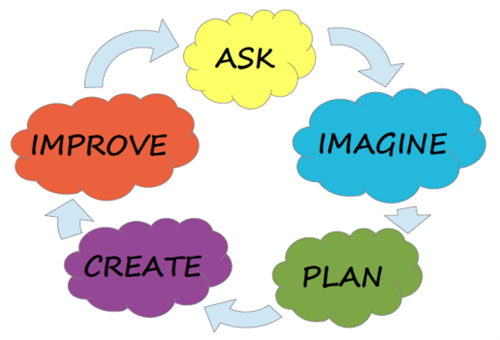 Integrated STEM education includes a range of different experiences that involve connections to real life problems. These experiences can occur in one to several class periods throughout the curriculum, but involve planning among teachers at and between grade levels as well as cooperative learning teams of students. Student teams work with design challenges that identify concepts and challenges that need to be addressed through potential solutions. The solutions are reviewed and revisited following testing to determine the depth of success and address changes that could offer improved solutions through the engineering design process.As a first year participant in STEM education during 2013 – 2014, each grade level chose a single design challenge to use with cross curricular extensions.Professional Development: Teachers Step Up to STEM!Fall 2013Before tackling STEM in the classroom, teachers practiced with a design challenge of their own, building a bridge out of balloons with limited materials and limited time!
Integrated STEM education includes a range of different experiences that involve connections to real life problems. These experiences can occur in one to several class periods throughout the curriculum, but involve planning among teachers at and between grade levels as well as cooperative learning teams of students. Student teams work with design challenges that identify concepts and challenges that need to be addressed through potential solutions. The solutions are reviewed and revisited following testing to determine the depth of success and address changes that could offer improved solutions through the engineering design process.As a first year participant in STEM education during 2013 – 2014, each grade level chose a single design challenge to use with cross curricular extensions.Professional Development: Teachers Step Up to STEM!Fall 2013Before tackling STEM in the classroom, teachers practiced with a design challenge of their own, building a bridge out of balloons with limited materials and limited time!

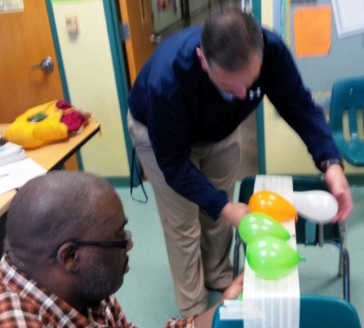
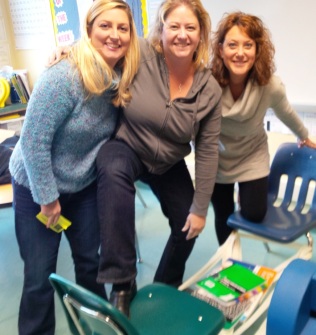 K – 3 Primary“The Three Little Pigs” Our primary grade students built houses to withstand the strong winds blown by the Big Bad Wolf in a STEM unit centered around The Three Little Pigs story. (Adaptation of an activity from Classroom Compass, Summer 1996, Vol. 2 Issue 3)
K – 3 Primary“The Three Little Pigs” Our primary grade students built houses to withstand the strong winds blown by the Big Bad Wolf in a STEM unit centered around The Three Little Pigs story. (Adaptation of an activity from Classroom Compass, Summer 1996, Vol. 2 Issue 3)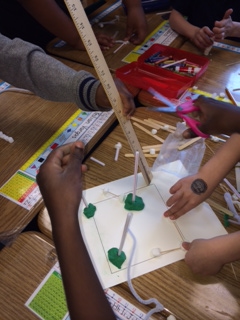

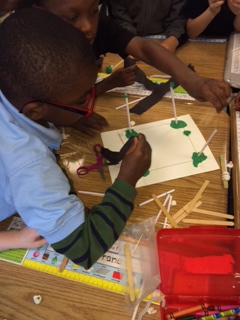 4 – 6 Intermediate Elementary
4 – 6 Intermediate Elementary“K’NEX Design Challenge Competition” Students from Mrs. Jane Ross’s fifth grade class attended the first ever STEM Design Challenge on March 14, 2014 at the Northwest Tri-County Intermediate Unit #5. The STEM Design Challenge is a new experience for Northwest Pennsylvania students. Originating out of Allegheny IU and supported through the joint efforts of K’NEX, Thermo Fisher Scientific and Carnegie Science Program Developer, Robert Marshall, students were challenged to us K’NEX as a tool to develop a people mover.
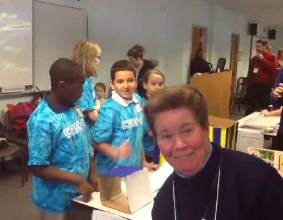
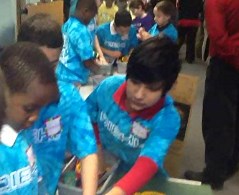
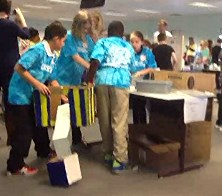 7 – 8 Middle School
7 – 8 Middle SchoolFall of 2013: Completed a cross curricular STEM lesson on Solar Energy.
2013-2014 Options 4 Sections of Engineering Challenge: students completed the spaghetti bridge challenge in the fall and during the spring began robotics using the Lego NXT kits.
Fall 2014: 7th and 8th grade students completed a water filtration STEM lesson.
2014-2015: We now cover 6 sections of STEM related options classes. There are 4 robotics working with the Carnegie Mellon robotics curriculum and 2 engineering sections. The engineering sections began the year completing a toothpick tower building tower, are finishing up the NASA thrust launcher challenge. Following the launchers, these sections will design, build, and test a single arm balance. In January, both sections will begin the IU5 K'nex Design Challenge for March 2015 competition at IU 5.
Spring 2015: 7th and 8th grade students will participate in a cross curricular STEM unit on sustainable gardening that will have a strong focus on Literacy and Science using the book Seedfolks as a central theme of diversity, teamwork, and science.
“Solar Ovens”
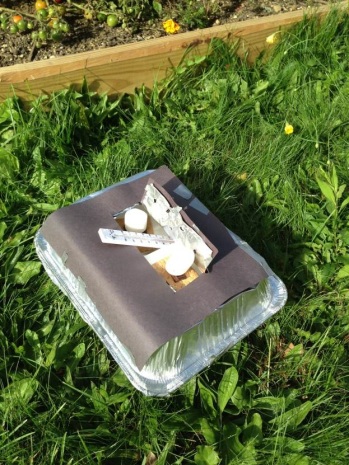
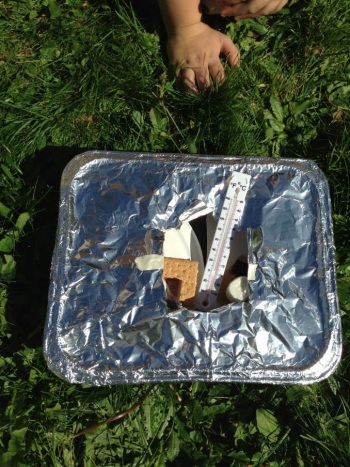
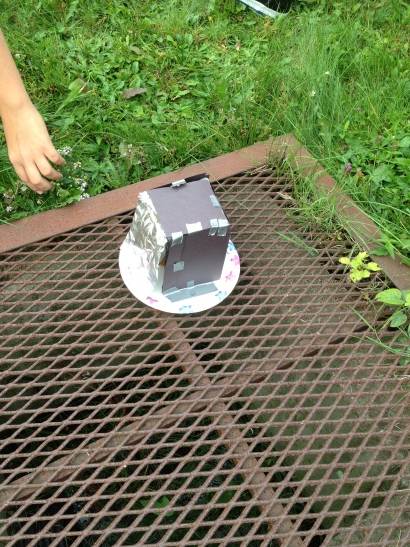 Harness the energy of the Sun to make the best snack ever invented. S’Mores!Spaghetti Bridges
Harness the energy of the Sun to make the best snack ever invented. S’Mores!Spaghetti Bridges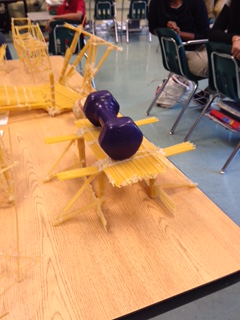

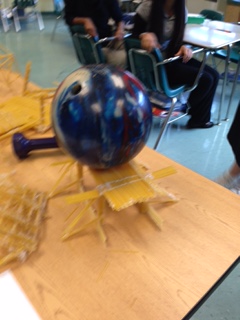
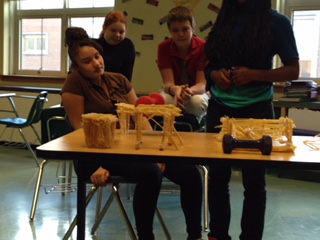 Toothpick Structures
Toothpick Structures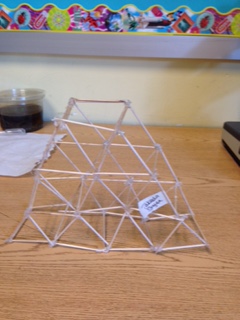
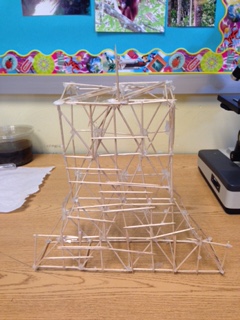 STEM 2014 - 2015
STEM 2014 - 2015
Diehl faculty met as a group on June 10, 2014 prepared to share classroom plans for STEM during the 2014 -2015 school year.Teachers eagerly presented ideas for STEM projects, proposed collaboration between classrooms, grade levels and content areas. After an hour of presentation and discussion, the following ideas had become a resource chart for the following year.KINDERGARTEN Will be following a Gingerbread theme. Two STEM projects are proposed for the year. One will be devising a trap to catch the gingerbread man. The other is the gingerbread man swimsuit challenge. GRADE 1 Gingerbread swimsuit challenge: Students will follow the description of the challenge to create a swimsuit that will keep the gingerbread man from dissolving when he goes swimming. Students will work through the addition problems keeping track of materials purchased for the challenge and retell/rewrite the story. One Hundred Day: Students will complete either the 100 block to build the tallest free standing structure or the 100 toothpick. Focus will be on linear measurement. Tie to trade book “Iggy Peck Architect”GRADE 2 Super Heroes working with the three phases of matter, solid,, liquid, and gas. This activity dovetails with the science module # 2 for grade 2. Students will work collaboratively to create a comic strip explaining the knowledge learned about phases and phase change. Narratives and oral presentation will be introduced with a focus on appropriate vocabulary.Working with the phys ed teacher, grade 2 will use pedometers to record and collect data concerning walking as a fitness activity. Students will also receive instruction in appropriate nutrition, walk for life fitness, and possibly attend a health fair.GRADE 3 Work with the water cycle is planned. Students will use online websites to create a 3D water cycle story; measuring diameter of evaporating mud puddles and graphing results. Culmination with a possible field trip to Camp Notre Dame for water cycle instruction. Students will repeat the experience of the three little pigs design challenge with house construction.GRADE 4 Students will be involved with the water bottle fountain challenge. Students will create a water fountain intended to spray for the longest period of time. GRADE 5 Students will be involved with a single design challenge. The activity will correlate with the science module “Motion and Design” during the second semester. The activity is the “Recycled Rover”. Using recyclable materials, students working in groups will design a Mars Rover for Mission 8. Classes will collaborate with the art teacher and a school wide specialist to create sketch/scale drawings. Focus on data collection and analysis. GRADE 6 Students will repeat the roller coaster experience as a collaboration between art and the classroom. Focus will be on data collection and display to demonstrate calculations for speed and distance. Students will be challenged to make learning visible through 3 dimensional project and brochure development. Students will work through ESL instruction and classroom literacy/social studies concerning architecture and construction of buildings. Column style with the Tower Design Challenge.Focus in the classroom will be on text complexity and reading. Students will integrate writing with narratives and letter writing explaining issues encountered during the challenge. Erie area architecture will also be integrated for additional content enhancement.GRADE 7 & 8 The science module concentration for the academic year is focused upon life science. Two modules are to be completed Organisms Macro to Micro for the first semester and Populations and Ecosystems will be the second module. Water will be the central theme focus for the design challenge. Students will be investigating water quality testing, and water treatment systems for filtration and potable water sources. Real world connections such as water filtration systems will be reviewed and the Erin Brockovich movie will be used in part as illustration. Students will be challenged to design a water filtration system to clean and recycle water. Grade 7 and 8 will integrate a trade book with appropriate life science content for inclusion into the curriculum.

